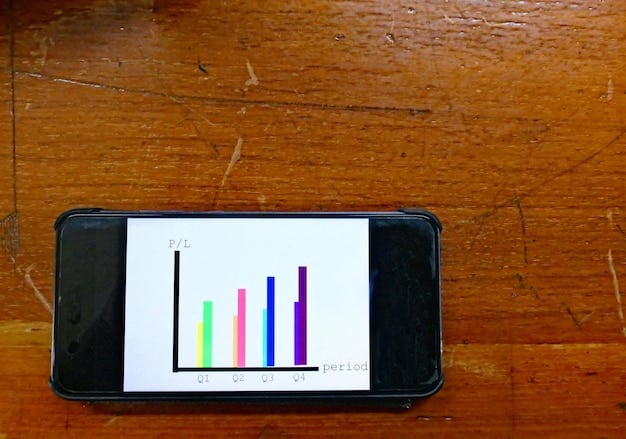How to Start Investing with $100: A Beginner’s Guide

Starting to invest doesn’t require a fortune; this guide shows you practical ways to begin investing with just $100, exploring micro-investing platforms, fractional shares, and ETFs to grow your money, even on a small budget.
How to Start Investing with Just $100: A Beginner’s Guide to Micro-Investing
Want to dip your toes into the world of investing but think you need thousands of dollars to get started? Think again! This guide will show you how to start investing with just $100: A Beginner’s Guide to Micro-Investing, proving that anyone can begin building wealth, no matter how small the initial investment.
Understanding the Basics of Micro-Investing
Micro-investing has opened the door for many to start investing with very little money. But what exactly *is* micro-investing, and how does it differ from traditional investing?
Micro-investing platforms allow you to invest small amounts of money, often through fractional shares or round-up programs. This makes it possible to buy into companies or funds that would otherwise be too expensive.
What are Fractional Shares?
Fractional shares are a key component of micro-investing. Instead of buying a whole share of a company, which can cost hundreds or even thousands of dollars, you can buy a fraction of a share.
Round-Up Investing
Another popular micro-investing strategy is round-up investing. With this method, every purchase you make is rounded up to the nearest dollar, and the difference is invested in a portfolio of your choice.

Micro-investing provides accessible entry points for individuals with limited capital, demystifying complex financial concepts and fostering a culture of early investment. These platforms not only lower financial barriers but also educate users on managing their investments effectively.
Choosing the Right Micro-Investing Platform
Selecting a micro-investing platform is crucial for beginners. Several platforms offer various features and benefits, so it’s essential to choose one that aligns with your investment goals and preferences.
- Robinhood: Known for its commission-free trading and user-friendly interface, is a great option for beginners.
- Acorns: This is popular for its round-up feature, which automatically invests your spare change.
- Stash: Stash offers educational resources and allows you to invest in fractional shares of stocks and ETFs with a focus on socially responsible investing.
When selecting a platform, consider factors like fees, investment options, educational resources, and user experience. A platform with low fees and comprehensive resources can help beginners learn and grow their investments effectively.
Ultimately, the right micro-investing platform is one that empowers you to start investing confidently and conveniently, regardless of your financial background or expertise.
Exploring Investment Options with $100
With just $100, you have more investment options than you might think. Diversifying your investments is a smart strategy, even with a small amount of capital. Different options cater to varied risk appetites and investment objectives.
With a limited budget, it’s important to focus on investments that offer diversification and growth potential without requiring large sums of money. Exchange-Traded Funds and certain stocks can be excellent starting points.
Exchange-Traded Funds (ETFs)
ETFs are baskets of stocks that track a specific index, sector, or investment strategy. With $100, you can buy fractional shares of ETFs, instantly diversifying your portfolio across numerous companies. This reduces risk and allows you to participate in broader market trends.
Individual Stocks
While buying a full share of some companies might be out of reach, many platforms offer fractional shares of individual stocks. This allows you to invest in companies you believe in, even with a small budget.
Carefully consider your risk tolerance and investment goals when choosing between ETFs and individual stocks. ETFs can provide instant diversification and reduce risk, while individual stocks offer the potential for higher returns but also carry greater risk.
Creating a Diversified Portfolio on a Budget
Diversification is key to managing risk, even when you’re investing with a small amount. Spreading your $100 across different asset classes and sectors can help protect your portfolio from market volatility.
A well-diversified portfolio can help mitigate potential losses and maximize long-term growth. But how do you achieve diversification with a limited budget?

- Invest in a Low-Cost ETF: Allocate a significant portion of your $100 to a low-cost ETF that tracks a broad market index, so that you can start spreading your investment across an array of stocks.
- Choose a Sector-Specific ETF: Consider investing a smaller amount in a sector-specific ETF that aligns with your interests or beliefs. This allows you to target growth opportunities in specific areas of the market.
- Research Individual Stocks: Set aside a small portion of your budget to invest in individual stocks of companies you believe in and that align with your investment strategy. Thoroughly research each company before investing.
Diversifying your investments with just $100 is possible and can set a solid foundation for future financial success. By carefully allocating your funds across different asset classes and sectors, you can build a resilient portfolio that weathers market fluctuations and positions you for long-term growth.
Setting Realistic Goals and Expectations
When you start investing with a small amount like $100, it’s important to set realistic goals and expectations. Understanding the potential returns and the time it takes to achieve your financial objectives is crucial for staying motivated and avoiding discouragement.
Investing is a long-term game, and patience is key, especially when starting with a small sum. While you may not get rich overnight, consistent investing and smart financial decisions can yield significant returns over time.
The Power of Compounding
Compounding refers to the ability of an asset to generate earnings, which are then reinvested to generate their own earnings. This means that your investments can grow exponentially over time.
Patience and Persistence
Investing is not a get-rich-quick scheme. It requires patience, discipline, and a long-term perspective. Don’t be discouraged by short-term market fluctuations or slow initial growth. Stay focused on your goals and continue investing consistently.
Setting realistic goals and embracing the power of compounding can transform your $100 investment into a substantial financial foundation. By staying patient, persistent, and informed, you can navigate the ups and downs of the market and achieve your long-term financial dreams.
Tracking Your Investments and Staying Informed
Once you’ve started investing, it’s important to track your investments regularly and stay informed about market trends and company performance. This will help you make informed decisions and adjust your strategy as needed.
Regularly monitoring your portfolio allows you to assess its performance, identify any potential issues, and make necessary adjustments to stay on track toward your financial goals. Staying informed about market news and economic developments is also crucial for making sound investment decisions.
- Monitor Your Portfolio Regularly: Set aside time each month to review your portfolio’s performance, assess your asset allocation, and identify any areas that may need attention.
- Stay Informed About Market Trends: Stay up-to-date on market news, economic developments, and industry trends that can impact your investments. Follow reputable financial news outlets and subscribe to investment newsletters.
- Rebalance as Needed: Over time, your asset allocation may drift away from your target due to market fluctuations. Rebalance your portfolio periodically to bring it back in line with your investment strategy.
By staying informed, regularly monitoring your portfolio, and making adjustments as needed, you can navigate the complexities of the market and achieve your long-term financial objectives with confidence.
Staying Disciplined and Investing Consistently
The key to long-term investing success is staying disciplined and investing consistently, regardless of market conditions. Developing good habits and sticking to your investment plan can help you build wealth over time.
Establishing a disciplined approach to investing can help you avoid emotional decision-making and stay focused on your long-term goals. Consistency means investing regularly, whether the market is up or down.
Automate Your Investments
Set up automatic transfers from your bank account to your investment account on a regular basis. This ensures that you are consistently investing, even when you’re busy or the market is volatile.
Avoid Emotional Decision-Making
Market fluctuations can trigger emotional responses, leading to impulsive decisions. Stick to your investment plan and avoid making rash decisions based on short-term market movements.
By prioritizing discipline, consistency, and a long-term perspective, you can weather market fluctuations and build a solid foundation for long-term financial success, regardless of your starting capital or market conditions.
| Key Point | Brief Description |
|---|---|
| 💰 Micro-Investing | Start investing with small amounts, like spare change. |
| 📚Choose a Platform | Select a platform like Robinhood or Acorns for beginners. |
| 📈 Diversify Investments | Spread $100 across ETFs and fractional shares. |
| 🎯 Set Goals | Be realistic about returns and invest for the long term. |
Frequently Asked Questions (FAQs)
▼
Yes, through micro-investing platforms and fractional shares, you can begin investing with as little as $100. It’s about starting early and consistently.
▼
Invest in a low-cost ETF that tracks a broad market index. This way, your $100 is spread across numerous companies, reducing risk.
▼
Micro-investing platforms often charge fees, such as monthly subscription fees or small transaction fees on certain trades. Review the fee structure before signing up.
▼
Yes, reputable micro-investing platforms are generally safe, but it’s crucial to do your research. Ensure the platform is regulated and uses encryption to protect your data.
▼
Don’t panic. Market fluctuations are normal. If you’ve diversified, losses in one area may be offset by gains elsewhere. Consider holding for the long term.
Conclusion
Starting to invest with just $100 is entirely possible and can be a smart way to begin building wealth. By understanding micro-investing, choosing the right platform, diversifying your investments, and staying disciplined, you can set yourself on the path to financial success, no matter how small your initial investment.





